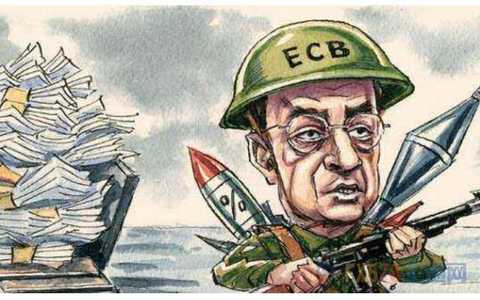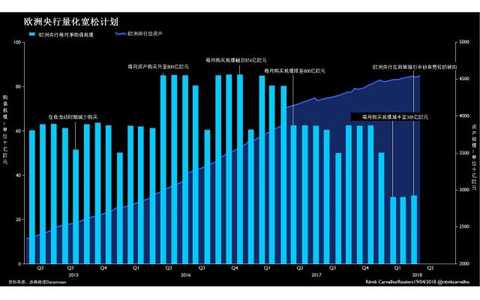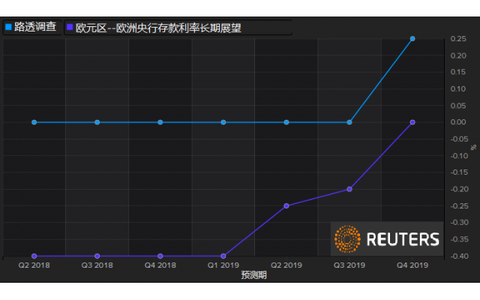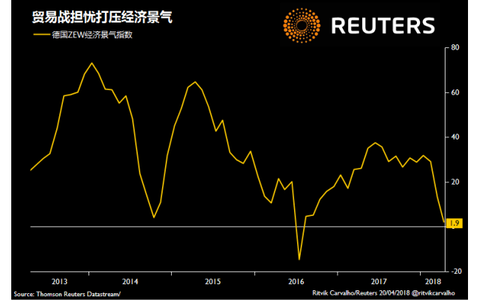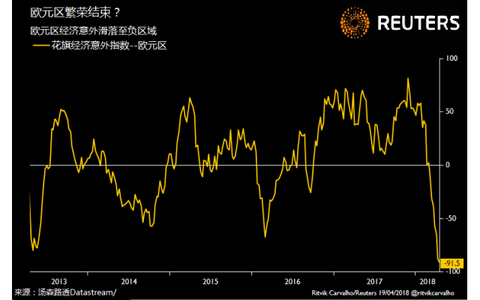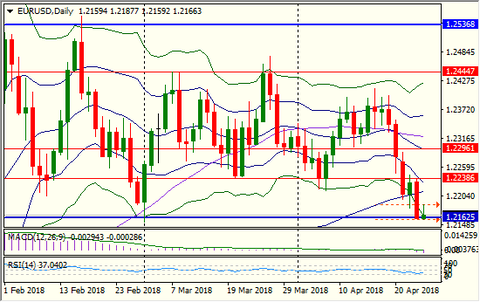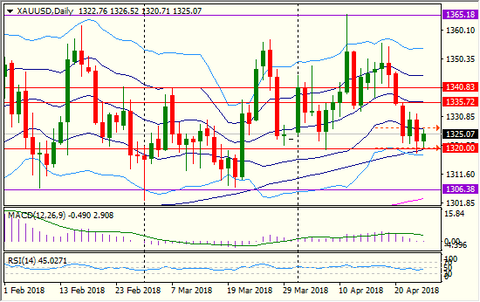Beijing time on Thursday (April 26) at 19:45 will announce the European Central Bank resolution, although the market is widely expected to expect the ECB to stand still this week, but investors hope to pass this resolution to speculate on the future policy path of the European Bank. What are the highlights of this resolution, what are the expectations of the major institutions, and whether the resolution can reverse the recent decline of the euro? Huitong Network Element is easy to break down for you. ★ Policy Review: European Bank's March fine-tuning policy guidelines, but the tightening policy is still blocked and long The European Central Bank kept monetary policy unchanged in the March 8th resolution, and in the policy statement announced at the same time, adjusted the wording about asset purchases, and removed the statement that “if the outlook deteriorates, it will increase the scale of bond purchasesâ€; The central bank said that policy interest rates will remain low until the QE plan ends "a long time later" and will be extended if necessary. At the press conference after the resolution, Draghi raised the GDP forecast and revised the inflation forecast; but Draghi pointed out that QE will continue until the management committee believes that the inflation path continues to adjust to the target level, no other Possible policy adjustments have been discussed, and it is not yet possible to declare victory in inflation. The main points of the Draghi press conference are as follows: Monetary policy: QE will continue until the management committee believes that the inflation path continues to adjust to the target level. The decision to adjust the QE wording is unanimously adopted, and no other possible policy adjustments are discussed; Economic expectation: The GDP growth rate in 2018 will be raised from 2.3% to 2.4%, and the economic growth rate in the Eurozone will exceed the previous expectations; Inflation expectations: The inflation forecast for 2019 will be lowered from 1.5% to 1.4%. After inflation will be 1.5% this year, the core inflation rate will gradually increase in the medium term; it is not yet possible to declare victory in inflation; Euro exchange rate: The European Central Bank will pay attention to exchange rate changes and financial conditions; Risk factors: Eurozone growth risks are generally balanced; downside risks are related to global factors, foreign exchange markets and trade protectionist threats; tariff changes are not currently referred to as trade wars. Huitong Netease believes that Draghi said that “there is no discussion on other possible policy adjustments, and it is not yet possible to declare victory in inflationâ€, which indicates that the ECB’s top management is not eager to substantially modify the policy guidelines, and is not in a hurry. Accelerating the tightening policy; in addition, the trade protectionism risk triggered by the Trump administration has also added uncertainty to the Eurozone economy, adding to the concerns of the European Central Bank. European Central Bank President Mario Draghi said on April 20 that the momentum of economic growth is expected to continue, with confidence that the inflation outlook has improved, but potential inflation in the euro zone is still suppressed, and patience, perseverance and prudence are needed. A full monetary stimulus is still needed. This remark shows once again that the European Central Bank is currently concerned about the inflation outlook, and policymakers may still hold a cautiously optimistic stance, and the line to tighten policy is still relatively flat. ★European silver resolution five major points this week Will the forward-looking guidelines change? Maybe not. After the European Central Bank took another small step to withdraw its 2.55 trillion euro asset purchase plan last month, the central bank is not expected to adjust its policy outlook on Thursday. However, discussions on future adjustments to the so-called forward-looking guidelines may be put on the agenda. The forward-looking guidance here includes the ECB's outlook on asset purchases and interest rates. The central bank is expected to gradually withdraw QE before the end of this year. Frederik Ducrozet, an analyst at Patek Asset Management, said: "It is in line with the interests of the European Central Bank. We know that communication will change, but the risk-reward situation supports the practice of waiting until June or later. The steps down." Will the ECB be inclined to hawks or doves? The dovish is more likely than the hawks. Concerns about the strength of the euro, the risk of Sino-US trade wars and the slowdown in economic momentum mean that ECB President Draghi may have a cautious view at the press conference after the meeting. European Central Bank (ECB) Management Committee member Nowotny said that the deposit rate can be raised by 20 basis points to start the rate hike process, but the European Central Bank quickly stated that this does not represent the views of the entire management committee. Money market price movements show that investors will push back the rate hike expectation to 2019, and the rumors that the European Central Bank will end its quantitative easing when the asset purchase plan expires in September are not sustainable. How much concern does the European Central Bank have about the global trade war? The risk of a full-scale trade war between the United States and other major economies is listed on the ECB’s list of concerns last month and is likely to re-emerge. For investors, the main problem is trade tensions, especially if the trade dispute between the United States and China affects the euro zone, whether the ECB’s carefully planned ultra-loose policy exit plan will change. European Central Bank Governing Council member Francois Villeroy de Galhau said last week that if inflation risks from protectionism, exchange rates, or market volatility lead to frustration, the ECB will have to change its monetary policy stance. Path. Trade concerns have also begun to affect investor confidence and economic growth expectations. Will the ECB emphasize the weakness of economic data? In fact, there have been further indications in recent weeks that the Eurozone economy has peaked and Draghi may emphasize this issue. According to data from purchasing managers in March, the expansion of Eurozone companies in the first quarter was the weakest since the beginning of 2017. In the euro zone, the inflation rate rose less than expected last month, and German investor confidence weakened. However, analysts said that the IMF raised its forecast for German economic growth last week, and the European Central Bank may also dilute the recent disappointing economic data. “As the economic downturn weakens, the market is less sensitive to ECB initiatives,†said Amois Bouvet, Mizuho’s interest rate strategist. "From a certain perspective, this is the window of opportunity for the ECB to discuss reforms and prepare the market for forward-looking guidance adjustments." How do you view the strong euro? The euro’s surge in the beginning of 2018 has recently stopped, bringing relief to the European Central Bank. The ECB is very sensitive to any signs that the strength of the euro is weakening the competitiveness of exporters. But investors are reinvesting funds in the euro zone, many are still optimistic about the euro, and the European Central Bank may reiterate concerns about the potential adverse effects of a strong euro. The euro trade-weighted exchange rate is still less than 1% lower than the three-and-a-half-year high reached on March 8, and the European Central Bank held a meeting on March 8. The euro is still close to a three-year high against the dollar. Analysts disagree on the impact of a more serious escalation of the tit-for-tat trade war on the euro. Given that the disputes have so far been largely confined to the United States and China, any adverse effects on the two largest trading partners in the Eurozone are more likely to impact the US dollar and the renminbi, boosting the euro. ★Institutional prospects ☆ Barclays: European Bank's April resolution is expected to be cautious, and the short-term euro is on the downside; On Thursday (April 26), the European Central Bank will announce the April interest rate decision. Barclays Research expects President Della to maintain a cautious stance, possibly putting pressure on the euro and short-term room for further weakness; In the process of normalizing monetary policy and changing the forward-looking guidance, the ECB management committee is not expected to disclose new signals. The recent weakening of economic data in the Eurozone and the warming of trade frictions in the market may lead to its reassessment of the balance risk; The interest rate market has re-priced the European Central Bank's tightening of monetary policy. The first time the deposit interest rate will increase by 10 basis points will be carried out in mid-2019, and the deposit rate will be raised from a negative value to 0% in the second quarter of 2020; EUR/USD is expected to fall within the range, with the median interval around 1.22, and the probability of an upward breakout is small. ☆ Morgan Stanley: In April, the interest rate decision of the European Bank has not changed much, and the QE signal may be issued in June; The European Central Bank’s April interest rate decision will be held on Thursday (April 26), and Morgan Stanley’s forecast for this is: Due to the removal of “loose bias†in the European Central Bank’s interest rate decision in March, it is expected that this April 26 meeting is unlikely to bring about further changes; We expect some major changes in the June resolution, when the ECB may issue a signal to end the QE in the fourth quarter of this year; After the end of the net asset purchase program, the large amount of assets accumulated by the ECB may be used for reinvestment for a long time, which will support the inflation trajectory and continue to implement lower interest rates. ☆ Nomura Securities: The European Bank is expected to remain inactive in April and announce a major decision in June; Nomura Securities said that in line with market consensus expectations, the ECB's April interest rate decision is expected to remain unchanged. It is difficult to disclose any new information that may significantly influence investors' expectations of its future policy path. Decision makers are unlikely to pay too much attention to the recent short-term expectations. Economic data; Although the core inflation in the Eurozone is sluggish, this is partly due to the appreciation of the Euro last year, but this will not change the market's perception of the ECB's long-term inflation outlook; At the press conference after the interest rate decision, President Draghi may be asked about the recent downturn data, owing to temporary factors such as job market turmoil and bad weather, and said that the global trade situation will be closely monitored; In terms of reducing the prospects of QE, it is expected to disclose relevant information in June. The basic expectation is that BOC will announce in June that it will reduce its monthly bond purchases to 15 billion euros in October and further reduce it to zero in November (January to September monthly bond purchases amounted to 30 billion euros), and in March 2019, the deposit rate was raised by 15 points, and further increased by 50 points in the second quarter to the fourth quarter of the year. ☆ Holland International Group: The European Bank’s April resolution is expected to be difficult to lower the euro, and a moderate rebound may occur; ING believes that after issuing a relatively dovish monetary policy stance in March, ECB President Draghi may reveal economic growth in the euro zone on Thursday's April interest rate decision to be held on Thursday (April 26) The worries of the future are either due to the slowdown in macroeconomic growth, or the uncertainty of global trade and geopolitical politics, or the simultaneous existence of both; If expected to cash, then the doctrine position of the European Central Bank will lead to the euro long position to leave, because the European Union's rate of increase in deposit interest rates in 2019 is further reduced, the euro may fall back to 1.21 against the dollar; However, if the expectations are not fulfilled, then from the perspective of risk/reward, the euro may rebound moderately, and this month Draghi is very difficult to pull the euro down from the comments; Given that the market's expectations for the ECB's April interest rate decision are relatively low, it is expected that the chances of Draghi's pigeons will cause the euro to fall. ☆ Mitsubishi UFJ: European silver is difficult to change the momentum of the euro zone trading, but there are still two major "surprise" can be expected; Mitsubishi Tokyo UFJ discussed the outlook for the euro against the US dollar and maintained a neutral stance on the exchange rate. It is expected to trade in the 1.22-1.25 range in the short term; This week's exchange rate is expected to continue the current range of trading momentum, the European Central Bank's April interest rate decision is unlikely to issue new hints, thus pushing the euro to break through the current trading range; However, the ECB's interest rate decision still has two potential "surprise" options: on the one hand, if the European Bank sends any signal to further tighten monetary policy, then the euro may continue to rise; On the other hand, if Eurobank is more worried about the recent slowdown in economic growth, then the euro may be further under pressure and further push the market to believe that the European Central Bank will postpone the first rate hike until the end of 2019. ★Market response prospects Scenario 1 (Basic Situation): The ECB maintains its monetary policy unchanged and maintains its forward-looking guidance. It maintains an optimistic view on the economic prospects of the Eurozone. However, it may be considered that the outlook for inflation recovery remains to be seen, and may indicate that trade protectionism is important. Deterministic risk. If the interest rate resolution is the above, it will basically meet market expectations and is expected to be considered a moderately eccentric pigeon. The euro is expected to maintain its recent weakness. It may fall below the 1.2153 key support level in the short-term and test the 1.21 mark, but then it may stop. Falling back and rising, limited downside; short-term mild and good for the US, bad gold. Scenario 2: The European Central Bank maintains monetary policy unchanged, but a. unexpectedly adjusts forward-looking guidance, wording becomes more hawkish, or b. indicates that the recent downturn is only temporary, the economic outlook is still optimistic, or c. implies euro zone inflation Will rise steadily, one or several of these three situations occur. Under the above circumstances, the resolution is expected to be interpreted by the market as a hawkish, and most traders are expected, expected to sharply increase the euro against the dollar in the short-term, re-testing the resistance near 1.2239 or even the 1.23 level near the 20-day moving average; short-term heavy losses The US dollar refers to and greatly boosts the price of gold. Scenario 3: The European Central Bank maintains its monetary policy unchanged and maintains its forward-looking guidance, but a. expresses concern about the recent weak economic data, b. implies that inflation is still facing significant resistance, c. said that easing is still necessary, cut A loose decision will be cautious and slow, and d. implies that the euro is not expected to be strong, and several of these four situations occur. Under the above circumstances, the resolution is expected to be interpreted by the market as an accidental dove. The short-term euro is expected to be hit hard again. It may fall below the 1.21 mark and further dip into the bottom. The short-term US dollar index may rise sharply and cause the price of gold to fall sharply. ★Technical analysis ★Technical analysis ☆ Euro day line short test key support level, long life hanging line On the weekly chart, the exchange rate fell below the 20-week moving average, MACD is dead, and is testing 1.2154 key support, neutral to the air; On the daily chart, the euro fell to the bottom of the box (around 1.2153/63) since January, and is currently testing the level. The double bollinger is opening downwards, MACD is dead, and bearish; If the European Union's resolution makes the exchange rate completely fall below 1.2153, it will be possible to further dip down to test the 1.21 mark and the 1.20 mark; Conversely, if the resolution keeps the exchange rate above 1.2153/63, it will likely back to the resistance zone of 1.2215-1.2239 and the 1.23 mark near the 20-day moving average. ☆ Gold is in danger of holding $1,320 key support, short-term partial line or box shock On the weekly chart, the gold price once again measured the 20-week moving average, but the box shock pattern is intact and the prospect is neutral; On the daily chart, the gold price fell below the 20-day moving average, and is currently testing the key support near $1,320, MACD is dead, but the Bollinger Band is running horizontally, neutrally empty; If the European Union's resolution falls below the key support level of $1,320, it is expected to further test the support of $1310 and $1,306; If the European Union decides to hawk the hawks, the spot gold will likely rebound and rebound. It will return to the US$1,330 and the 20-day moving average of 1,333.72 US dollars. However, it is expected to stabilize the current 20-day moving average. (Editor: Fang Fengjiao HF055) Coil Zipper,YKK Coil Zipper,YKK Environmental Zipper,YKK Luggage Zipper YKK AUTHORIZED DISTRIBUTOR , https://www.ykkzipperdw.com